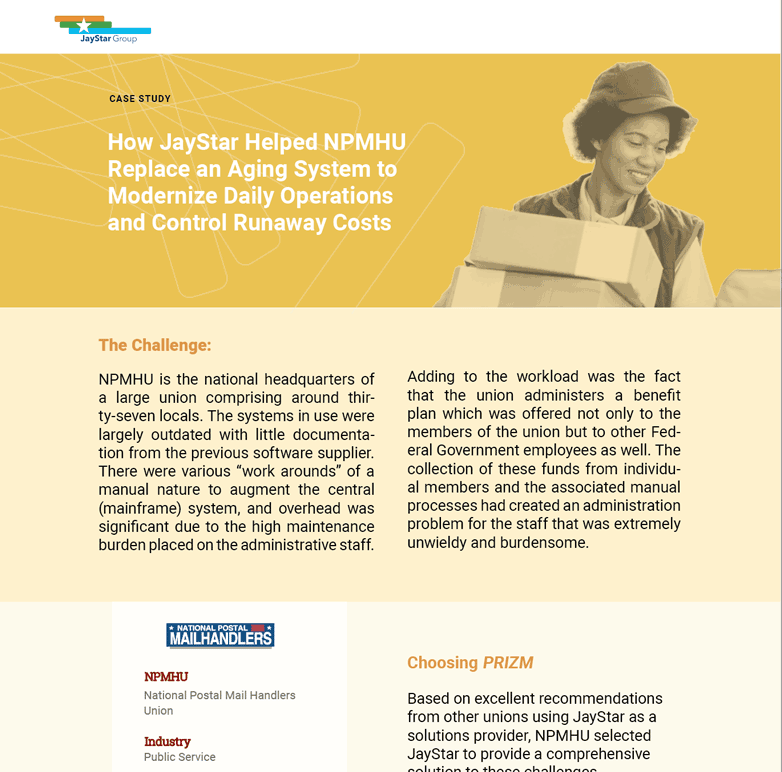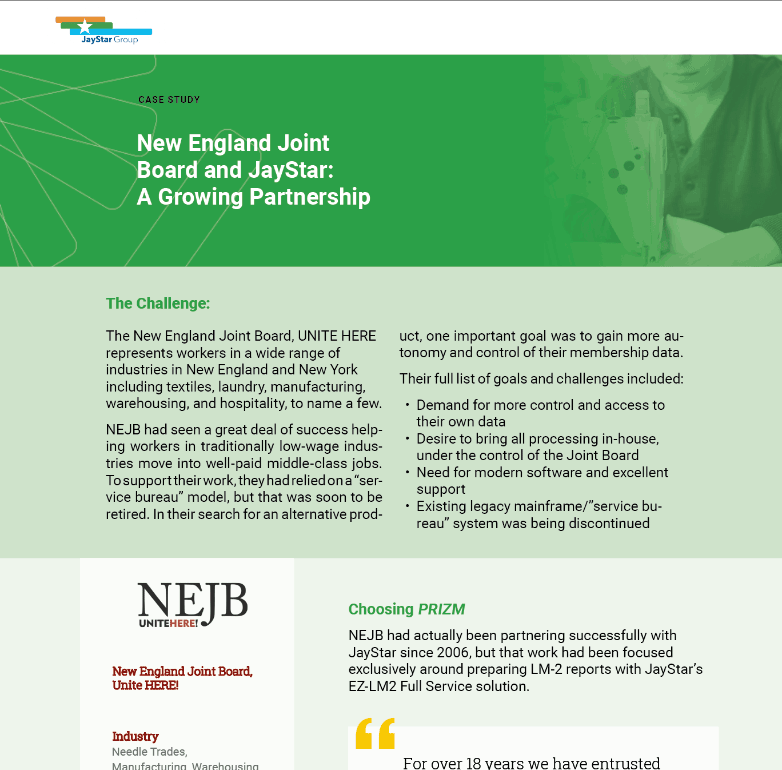
We help our clients tackle their biggest membership challenges
Learn how we are striving to make more satisfied customers every day
Our Clients
At JayStar, there is nothing more important than our clients.
From Locals to Internationals, 200+ labor organizations, first responders, and other associations rely on JayStar Group.
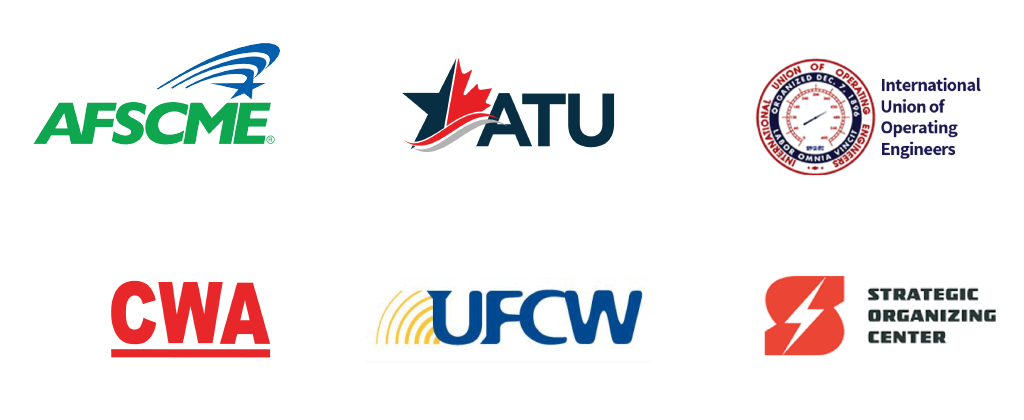

![]() CASE STUDY
CASE STUDY
NPMHU saved time and money while maintaining organizational workflow. The secret? Moving away from outdated legacy software and automating dozens of manual billing and membership tasks with an all-in-one modular PRIZM system designed by JayStar.
… read more
![]() CASE STUDY
CASE STUDY
New England Joint Board UNITE HERE already knew JayStar from years of support around LM-2 compliance. When it came time to transition off their legacy membership system, NEJB partnered with JayStar again knowing they’d be working with technologists who really understand Labor and getting the same world-class support they’d been receiving for years.
… read more
Want to talk about working with us?
CUSTOMER SUCCESS STORIES
TESTIMONIALS

JayStar Group took the time to truly understand our organization and the intricacies of our operations. The support is practically instantaneous and always available when needed.
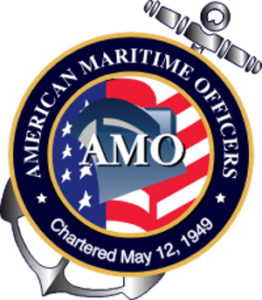
–AMERICAN MARITIME OFFICERS

For over 17 years we have entrusted JayStar Group for our complete membership solution. We know that we can depend on JayStar as if they were valued members of our staff.
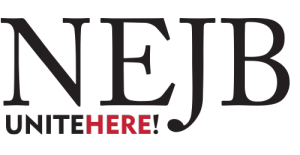
– ETHAN SNOW
Secretary-Treasurer
New England Joint Board, UNITEHERE!

With PRIZM, I believe our Local has one of the most advanced membership systems in the industry.
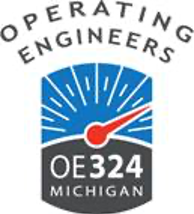
– SCOTT HART CPA, CGMA
Chief Financial Officer
Operating Engineers 324

JayStar's LM-2 preparation service is first rate.
The Local has been using JayStar since 2006. JayStar’s LM-2 services team has always welcomed questions, given expert guidance, and collaborated with the Local to ensure the timely filing of the LM-2 each year.
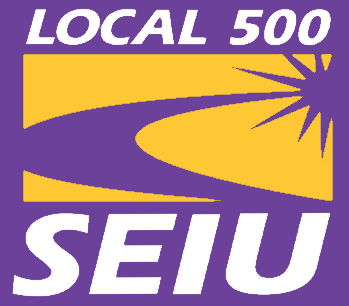 –THERESA ALEXANDER
–THERESA ALEXANDER
HR/Financial Director
SEIU Local 500

JayStar Group has prepared the New England Joint Board’s Form LM-2 since the regulations changed in 2005.
They have developed an understanding of the intricacies of our organization that gives us comfort that our forms are being prepared accurately. Their ability to analyze our data and prepare our forms in a timely manner makes the entire process worry-free.

– Ethan Snow
Secretary-Treasurer
New England Joint Board, UNITEHERE!

I used to give up my weekends preparing our LM-2. Now JayStar performs that service. They prepare an accurate, perfectly balanced LM-2 on time and on budget.

– SCOTT HART CPA, CGMA
Chief Financial Officer
Operating Engineers 324

We rely upon and trust JayStar to accurately and timely prepare our LM-2. Not only has JayStar been preparing our LM2 since 2006, the JayStar Team also helps us with some other related bookkeeping services.
JayStar makes what would be otherwise confusing and difficult tasks straightforward and clear. And, JayStar balances our LM-2 to the penny!
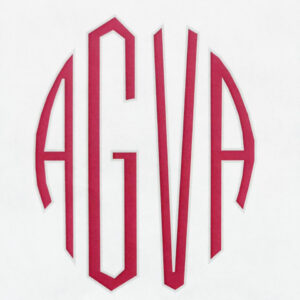
– SUSANNE K. DORIS
Executive Secretary-Treasurer
American Guild of Variety Artists

I have been working with JayStar over 10+ years and the part I love is the support and guidance.
We work closely together to review, troubleshoot and prepare our LM-2s on a timely basis. Having that support makes it effortless and less stressful. Team is very knowledgeable and professional at all times.

– MARCIA E. AZEEZ, CPA, CGMA
Chief Financial Officer
Hotel & Gaming Trades Council
AFL-CIO Local 6
We’re here to help. Let’s find a system to match your membership.
![]()
First Responders and Other Associations
Integrated modules to help first responders and other associations meet all their membership needs
![]()
Unions
All-in-one solutions designed for the special needs of unions and their members
Let’s get started. Sign up for a demo or informational phone call.

 Want to talk about our other solutions?
Want to talk about our other solutions?
Schedule a free informational call to learn what we can do for your organization.
